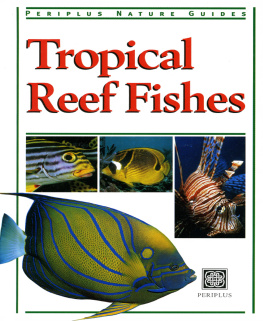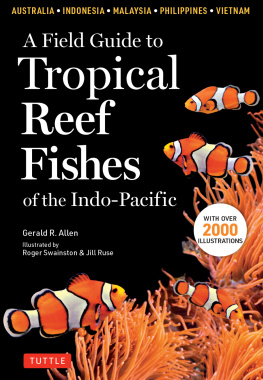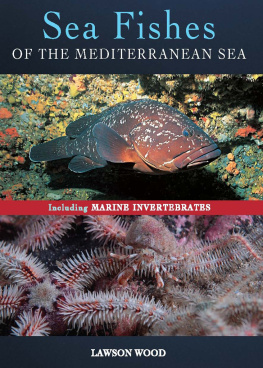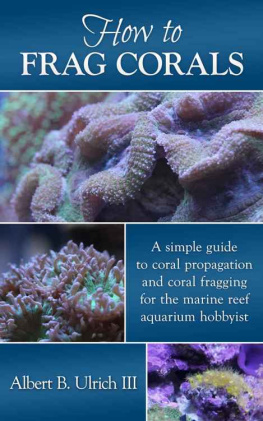Leopard Shark
Stegostoma fasciatum
Family: Stegostomatidae
The Leopard shark is distinguished by a whisker or "barbel" at each corner of the mouth, prominent ridges on the side of the body and a huge tail, which makes up about one-half of its total length. Adults, which grow to more than 300 cm, have a distinctive pattern of leopard-like spots. Another common name for this species is Zebra shark, based on the juvenile patternprimarily black with vertical white bands. Of all the sharks in the tropical Indo-Pacific region it is among the easiest to identify due to its colour, shape and habit of resting on the bottom. It feeds mainly on gastropod and bivalve molluscs, but crustaceans (crabs and prawns) and small fishes are also eaten. There is very little information about its behaviour, other than its habit of lying on the bottom for long periods. Females are known to deposit several large (approximately 8 x 17 cm), blackish egg cases. There are no reports of human attacks by this species. It pays little attention to divers or flees at their approach.

Blacktip Reef Shark
Carcharhinus melanopterus
Family: Carcharhinidae
This is one of the most commonly seen sharks in the Indo-Pacific region. It prefers shallow water close to shore, often on reef flats as shallow as 30 cm. Maturity occurs at a size of about 100 cm and the maximum length is about 170 cm. The young, which are born alive, measure between 33 and 52 cm. The Blacktip is an active, strong-swimming shark that occurs singly or in small groups. The diet consists mainly of small fish, cephalopods and shrimps. While not considered a dangerous shark, it has attacked humans. Most attacks appear to be cases of "mistaken identity"instinctively homing in on the wader's splashes and mistaking the disturbance for struggling fish. The species is commonly seen in public aquaria.
In the 1960s, the author sent the first live shipment of young Blacktips to the Steinhart Aquarium in California. The sharks were captured by hand at low tide on the reef flat at Enewetak Atoll in the central Pacific.

Silvertip Shark
Carcharhinus albimarginatus
Family: Charcharhinidae
This sleek predator is common in clear water, particularly on steep slopes, below depths of 20-30 metres. The geographic range extends from East Africa and the Red Sea to the Pacific coast of Central America. It is a dangerous species that is known to attack humans. It has the habit of passing uncomfortably close to divers should they enter its territory. Its normal food consists of a variety of fishes, including wahoo, eagle rays, wrasses and tunas. It will also consume octopuses and squids.
This shark should not be confused with the Reef whitetip, a harmless, relatively sluggish species that is often seen in shallow water. Both sharks have similar white markings on the dorsal and caudal fin, but the Whitetip is more slender and lacks white on the pectoral fin tips. The maximum size of the Silvertip is about 200 cm. The young, which measure between 63 and 68 cm, are born alive. Each litter contains 5 or 6 babies, but there may be as many as 11.

Scalloped Hammerhead Shark
Sphyrna lewini
Family: Sphyrnidae
The odd head shape typical of this family of sharks has been the subject of considerable speculation. Scientists believe it serves a twofold purpose of increasing manoeuvrability and enhancing sensory capabilities. The uniquely flattened head acts as a bowplane, allowing it to move swiftly through the water. The expanded surface area along the front of the "hammer" is crammed with special sensory cells for detecting pressure changes and electromagnetic fields, not unlike the sensor plate of a metal detector. In addition, the widely-spaced eyes may enhance their binocular vision.
The family contains nine species, of which the Scalloped hammerhead is one of the most common and widely distributed. It occurs in all tropical and warm-temperate seas. They sometimes congregate over sea mounts or around offshore islands, forming schools of hundreds of individuals. This shark is potentially dangerous, but attacks are rare. Maximum size is about 400 cm.

Manta Ray
Manta birostris
Family: Mobulidae
The distinctive Manta rays are easily recognised by the pair of large protruding flaps in front of the mouth, the lateral eyes, large wing-like appendages (actually modified pectoral fins), lack of a tail spine (some may have a rudimentary spine) and the tiny dorsal fin at the base of the tail. The head flaps are used to swoosh planktonic food into the mouth. It is ironic that such a huge animal feeds on tiny zooplankton. The largest mantas are reported to grow to a width of nearly 7 m and weigh more than 1,300 kg, making them one of the largest of all fishes. The family occurs in all warm seasabout 10 species are known. Large mantas are frequently sighted from boats, sometimes far out to sea. They are also regularly encountered by divers in the vicinity of coral reefs. One of the best areas to view them is around Sangalaki Island, off the northeastern coast of Kalimantan (Indonesian Borneo). Here they can be seen almost every day of the year, often performing spectacular leaps above the surface.

Ribbon Eel
Rhinomuraena quaesita
Family: Muraenidae
The bright-coloured Ribbon eel is aptly named. Although the head is roughly cylindrical, its body is thin and ribbon-like. Unlike most morays belonging to the same family, it lives in sandy burrows. It is usually seen protruding its head and up to about one-third of the body length outside the burrow. Aside from coloration and shape, the most distinguishing feature is the enormously expanded nostrils, which form a membranous scoop-like structure. If threatened, for example when closely approached by a diver, the eel swiftly retreats into its burrow, waiting several minutes before emerging.
Juveniles and small adults are mainly black with a yellow dorsal fin. Males become blue on the body and have a characteristic yellow snout. Adult females are entirely yellow except for white fin margins and a black anal fin. The species is widely distributed in the Indo-West Pacific region, ranging from East Africa to the Tuamotus and northwards to Japan. Maximum length is at least 130 cm.

Giant Moray
Gymnothorax javanicus
Family: Muraenidae
There are dozens of moray eel species on tropical coral reefs, but most are shy and seldom seen. They inhabit the endless cracks and fissures that riddle the reefs surface. The Giant moray is a notable exception that is often sighted by divers and has a particularly vicious appearance. Growing to a length of at least 2.2 metres and 30 kg weight, it is the largest moray eel living in the vast Indo-Pacific region. Like most morays, its jaws are equipped with numerous sharp fangs, which are normally used for capturing fishes or crustaceans. However, they can inflict nasty wounds on careless divers. For this reason it is not advisable to blindly probe deep crevices with your arms while diving, possibly in search of shells or lobsters. Nor is it advisable to spear large eels. They can easily spin off a spear and may vent their anger by biting savagely. In contrast, unprovoked specimens are usually docile and will allow divers to photograph them at close range or even feed and pet them.
















